SDTEST® has 36 different VUCA polls that calculate the 13,034 correlation values between stages of development according to the theory of Spiral Dynamics and answer options of these 36 polls.
We invite curiosity about the systemic mechanisms behind this correlation. There may be hidden variables that provide alternative explanations.
In our analysis of the poll "12 ways to build trust with others" (by Justin Wright [!]), we found an intriguing positive correlation that warrants closer examination:
0.4460 between the Tell the truth (Honesty lays the foundation for trust) / Agree and the Purple stage (Ukraine, Ukrainian).
The critical value of the correlation coefficient for a non-normal distribution, by Spearman r = 0.1767. This positive correlation of 0.4460 meets the reliability criteria but does not necessarily imply causation.
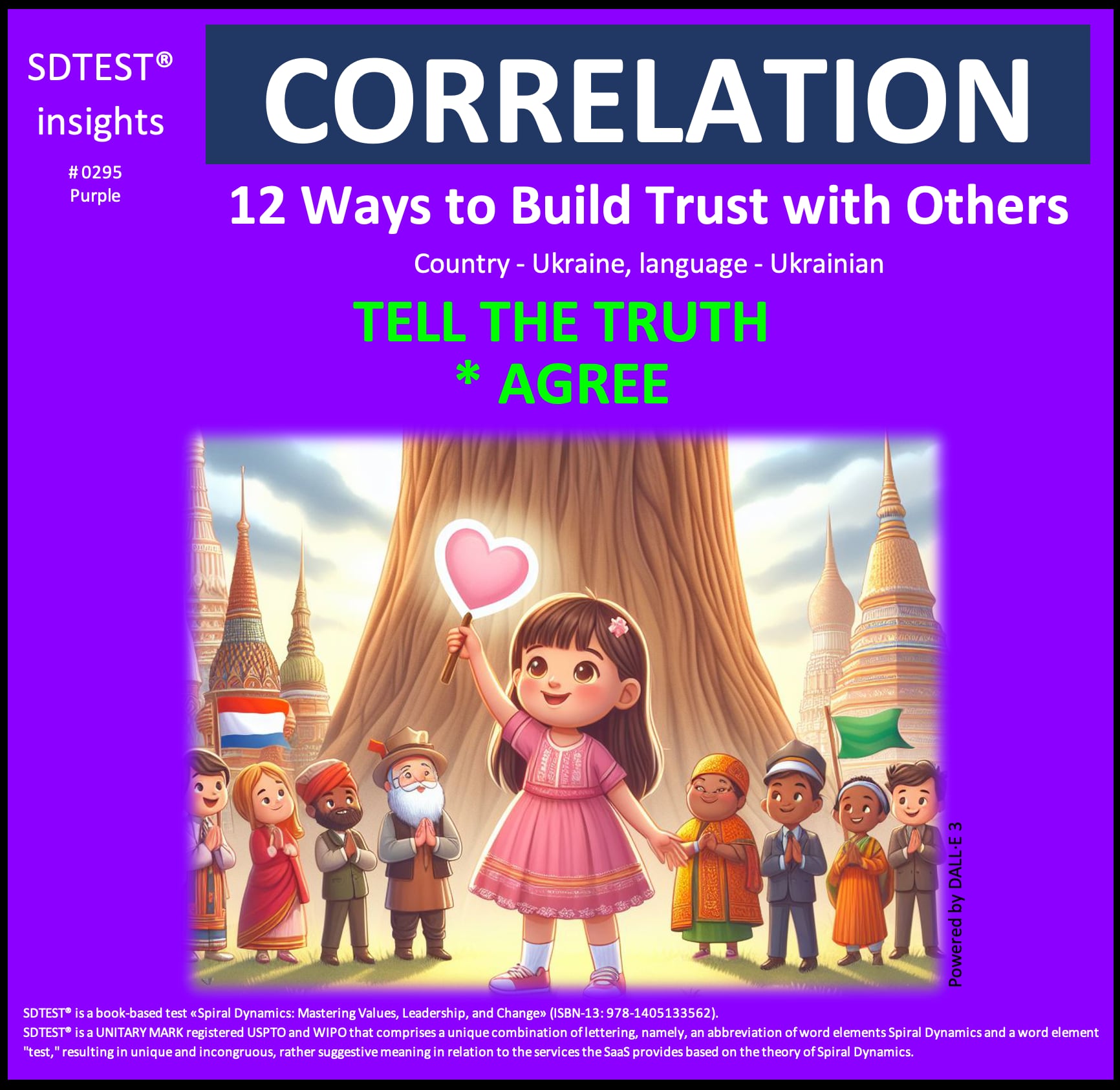
This positive correlation of 0.4460 between "Tell the truth" as a way to build trust and the Purple stage in Ukrainian-speaking Ukraine offers poignant insights when viewed through the lens of the Purple value system, especially considering the ongoing war, loss of life, economic struggles, and political challenges:
Organizational Perspective:
Organizations operating within the Purple mindset might interpret this correlation as:
- A call to return to ancestral values of honesty as a way to heal Ukraine's wounded collective spirit.
- Confirmation that truth-telling is crucial for maintaining group cohesion during extreme hardship and uncertainty.
- Evidence that upholding traditional virtues like honesty can provide spiritual protection against the chaos of war and corruption.
These organizations might respond by:
- Conducting rituals or ceremonies to cleanse the spiritual environment of lies and deceit.
- Implementing systems that honor those who tell difficult truths about the war and its impact on communities.
- Promoting leaders seen as direct conduits to ancestral wisdom, capable of discerning and speaking truth in troubled times.
Team Perspective:
Teams operating from a Purple mindset might approach this correlation by:
- Viewing it as affirmation that honest communication is vital for the team's survival in a war-torn environment.
- Interpreting it as support for using truth-telling to maintain group solidarity in the face of external threats and internal corruption.
- Seeing it as validation for prioritizing honesty to honor fallen comrades and preserve the group's spiritual integrity.
These teams might respond by:
- Creating sacred spaces where team members can safely share truths about their experiences of war and hardship.
- Encouraging sharing stories that demonstrate how honesty has protected the group from harm or betrayal.
- Developing rituals that use truth-telling to fortify the team against the corrupting influences they face spiritually.
Individual Perspective:
Individuals aligned with the Purple value system might interpret this correlation as:
- Personal validation of their belief that truthfulness can provide spiritual protection in dangerous and uncertain times.
- Evidence supporting their intuition that honesty is crucial for maintaining their place within a community under stress.
- Confirmation that upholding the tradition of truth-telling is a way to honor those who have died and to ensure their sacrifices were not in vain.
These individuals might respond by:
- Viewing their commitment to truth as a form of spiritual warfare against the forces of corruption and deceit.
- Using truth-telling to maintain a connection with lost loved ones and ancestral spirits for guidance.
- Seeking elders or spiritual leaders who can help them discern truth in conflicting information.
The reasons why "Tell the truth" might be seen as crucial for building trust in modern Ukraine for Ukrainian-speaking people in the Purple stage, given the current conditions, could include:
- Spiritual Resilience: Truth-telling might be viewed as a way to maintain spiritual strength and resilience in war and hardship.
- Community Preservation: Honesty is essential for preserving the integrity of communities fractured by conflict and economic stress.
- Ancestral Honor: Upholding the truth might be viewed as a way to honor ancestors and fallen compatriots, ensuring their sacrifices are acknowledged and remembered.
- Protection Against Corruption: Some might believe that collective truthfulness provides supernatural protection against the corrupting influences plaguing the country.
- Ritual Purification: Truth-telling could be seen as a crucial component of rituals aimed at cleansing the nation of the spiritual pollution caused by war and deceit.
In light of Ukraine's current struggles, this correlation prompts us to consider how traditional values like honesty can serve as anchors of stability and trust in times of extreme upheaval. It raises questions about the potential healing power of acknowledging painful truths and the role of traditional worldviews in helping communities cope with trauma and uncertainty.
Ultimately, this correlation highlights the complex interplay between cultural values, spiritual beliefs, and social trust in a nation facing existential threats. In the Purple-dominant environments of Ukrainian-speaking Ukraine, truth-telling might be seen not just as a personal virtue but as a sacred duty that maintains a community's spiritual and social fabric under immense strain, offering a path toward healing and renewal amidst the chaos of war and corruption.
-0.0915 between the Employees for which have not changed anything and the Red stage.
The critical value of the correlation coefficient for a normal distribution, by William Sealy Gosset (Student) r = 0.0867. This negative correlation of -0.0915 meets the reliability criteria but does not necessarily imply causation.
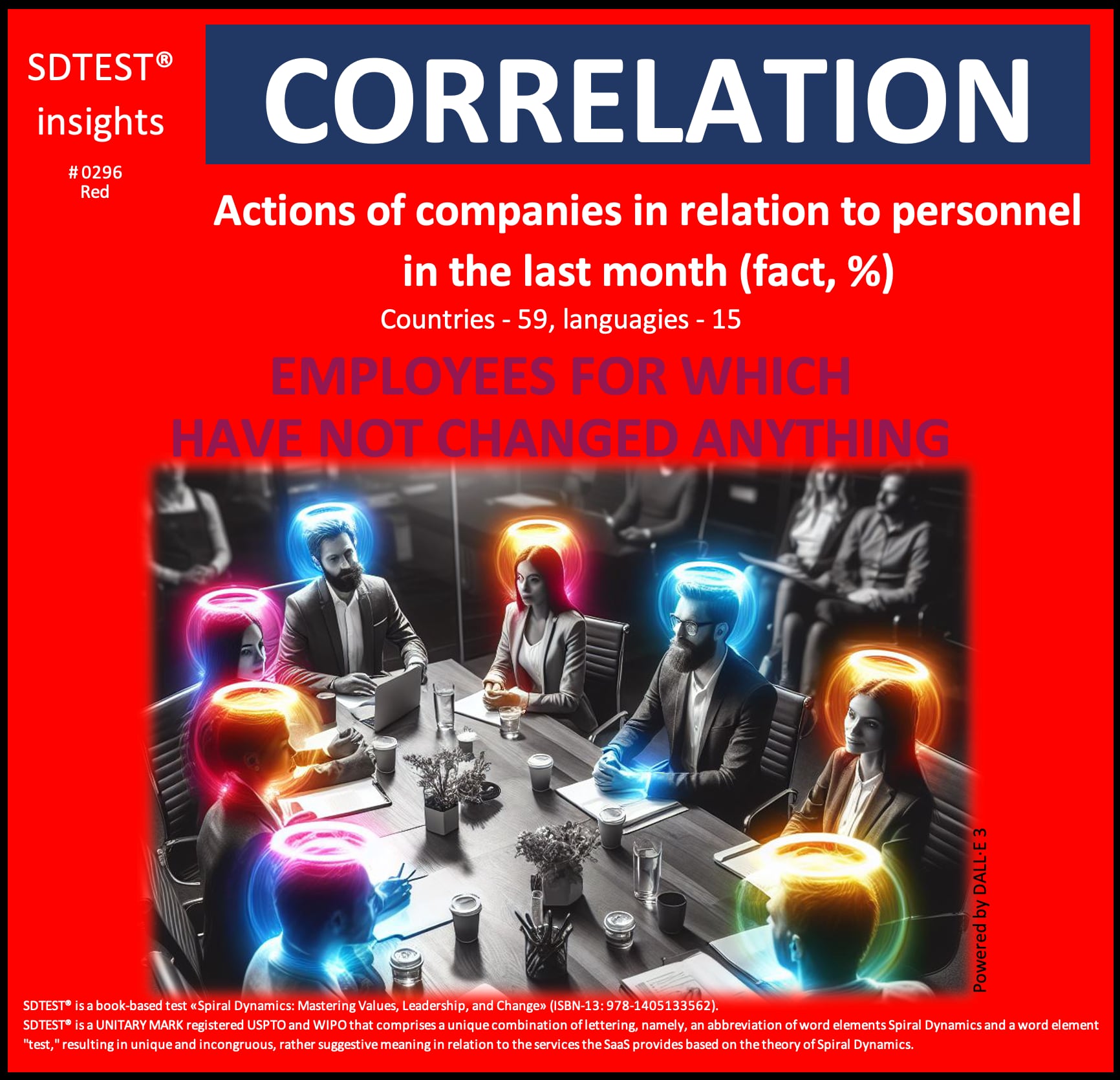
This negative correlation of -0.0915 between "Employees for which have not changed anything" and the Red stage offers intriguing insights when viewed through the lens of the Red value system:
Organizational Perspective:
Organizations operating within the Red mindset might interpret this correlation as:
- Validation of their aggressive, power-driven approach to managing employees.
- Confirmation that maintaining the status quo is weak and ineffective in their competitive environment.
- Evidence supporting their belief that constant change and upheaval keeps employees on their toes and responsive to authority.
These organizations might respond by:
- Implementing more frequent and dramatic changes in employee roles, responsibilities, or working conditions.
- Creating a culture of unpredictability to assert dominance over employees and keep them in a state of constant alertness.
- Rewarding managers who frequently shake up their teams or departments, regardless of the outcomes.
Team Perspective:
Teams operating from a Red mindset might approach this correlation by:
- Viewing it as an affirmation of their need for constant action and change to maintain team dominance.
- Interpreting it supports their belief that stability breeds weakness and complacency within the team.
- Seeing it as validation for prioritizing bold, impulsive decisions over careful planning and consistency.
These teams might respond by:
- Regularly reshuffling team roles and responsibilities to keep members competing for positions.
- Encouraging team leaders to make sudden, dramatic changes to assert their authority.
- Celebrating disruption and change as demonstrations of the team's power and adaptability.
Individual Perspective:
Individuals aligned with the Red value system might interpret this correlation as:
- Personal validation of their belief that staying in the same position or condition is a sign of weakness.
- Evidence supporting their intuition that constant change is necessary for personal power and success.
- Confirmation of the value they place on assertiveness and the ability to shake things up.
These individuals might respond by:
- Actively seeking opportunities to create change in their work environment, even if it's disruptive.
- Viewing stability in their job as a threat to their power and status.
- Using periods of organizational stability as a chance to assert themselves and force change.
This correlation, viewed through the Red lens, suggests that those operating at the Red level may be less likely to accept unchanging conditions for employees. It implies that the Red value system's assertiveness, competitiveness, and focus on immediate gratification align with a more dynamic and potentially volatile approach to employee management and organizational structure.
The reasons why employees for which nothing has changed might be seen negatively in the Red stage could include:
- Power Dynamics: Lack of change might be viewed as a failure to assert dominance or influence within the organization. In the Red stage, power is constantly contested, and unchanging conditions could be seen as a missed opportunity to climb the hierarchy.
- Competitive Edge: Stability could be seen as losing ground in the constant battle for supremacy and resources. Red-stage thinking values being ahead of others, and unchanging conditions might be interpreted as falling behind.
- Self-Expression: Unchanging conditions might be interpreted as suppressing individual desires and impulses. The Red stage prioritizes personal will and expression, so a lack of change could feel stifling.
- Immediate Gratification: The absence of change could frustrate those seeking constant stimulation and new conquests. Red-stage individuals often crave excitement and immediate rewards.
- Perceived Weakness: Employees in stable positions might be seen as complacent or lacking in ambition and drive. In the Red stage, strength is often equated with the ability to create change and disruption.
This correlation prompts us to consider how different value systems influence organizational stability and change perceptions. It raises questions about the potential benefits and drawbacks of a Red approach to employee management, particularly in contexts where long-term planning and consistent performance are crucial.
Ultimately, this correlation highlights the complex interplay between cultural values, organizational dynamics, and individual behavior. In Red-dominant environments, employees' lack of change might be seen not as a sign of stability or satisfaction but as a missed opportunity for asserting power, gaining advantage, or expressing individual will. This perspective could drive a cycle of constant upheaval as individuals and groups vie for dominance and immediate gratification, potentially at the cost of long-term organizational health and employee well-being.
-0.0791 between the Active listener and the Blue stage.
The critical value of the correlation coefficient for a normal distribution, by William Sealy Gosset (Student) r = 0.0403. This negative correlation of -0.0791 meets the reliability criteria but does not necessarily imply causation.
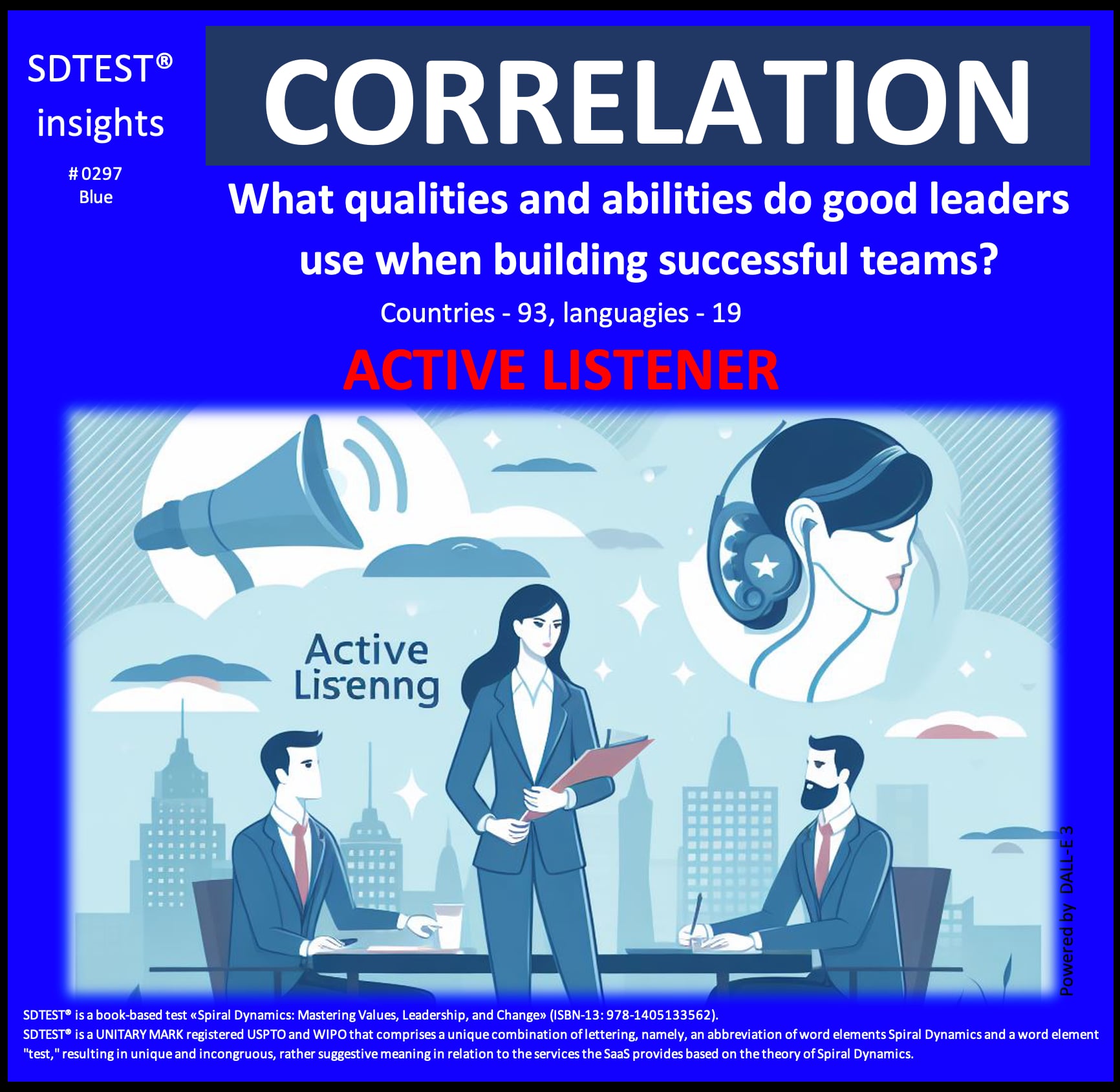
This negative correlation of -0.0791 between "Active listener" as a leadership quality and the Blue stage offers intriguing insights when viewed through the lens of the Blue value system:
Organizational Perspective:
Organizations operating within the Blue mindset might interpret this correlation as:
- Validation of their belief in top-down solid leadership and clear hierarchical structures.
- Confirmation that active listening detracts from those in command's authority and decision-making power.
- Evidence supporting their view that effective leaders must be decisive, unwavering, and able to enforce the organization's moral code.
These organizations might respond by:
- Emphasizing leadership qualities like decisiveness, discipline, and adherence to tradition over active listening.
- Implementing strict protocols and communication channels that limit the need for leaders to listen to subordinates actively.
- Promoting individuals to leadership roles who demonstrate a strong command presence and willingness to issue directives without extensive consultation.
Team Perspective:
Teams operating from a Blue mindset might approach this correlation by:
- Viewing it as an affirmation of their belief in the leader's right to issue orders and expect unquestioning obedience.
- Interpreting it as support for their practice of deferring to the judgment and moral authority of those in positions of power.
- Seeing it as validation for prioritizing discipline, loyalty, and adherence to established procedures over open-ended dialogue.
These teams might respond by:
- Actively discouraging team members from challenging or questioning the directives of their leaders.
- Fostering an environment where active listening is seen as a sign of weakness or insubordination.
- Celebrating instances where leaders assert their dominance and make decisive, unilateral decisions without extensive input.
Individual Perspective:
Individuals aligned with the Blue value system might interpret this correlation as:
- Personal validation of their belief that true leaders are strong, authoritative, and unwavering in their convictions.
- Evidence supporting their intuition that listening too closely to subordinates undermines the leader's moral authority.
- Confirmation of the value they place on following a clear chain of command and respecting the judgments of those in positions of higher rank.
These individuals might respond by:
- Actively seeking out leadership roles where they can assert their moral and positional authority without needing active listening.
- Viewing active listening as a sign of indecisiveness or a lack of confidence in one's own beliefs and decisions.
- Using opportunities to criticize or undermine leaders who they perceive as being too accommodating or open to the input of their team members.
This correlation, viewed through the Blue lens, suggests that those operating at the Blue level may be less likely to value active listening as a leadership quality. It implies that the Blue value system's emphasis on order, hierarchy, and adherence to established rules and traditions aligns with a more directive, top-down approach to team management.
The reasons why "Active listener" might not be seen as a desirable leadership quality in the Blue stage could include:
- Hierarchy and Authority: In the Blue stage, the leader's power and moral authority position is paramount. Active listening could be seen as a concession of that authority.
- Adherence to Tradition: Blue-stage organizations often value the established ways of doing things. Active listening may be perceived as a departure from traditional leadership models.
- Decisive Action: Blue-stage thinking favors swift, decisive action based on well-established principles. Active listening could be interpreted as indecisiveness or a lack of conviction.
- Moral Code Enforcement: Blue-stage leaders are often tasked with upholding and enforcing a strict moral code. Active listening may be seen as diluting or compromising that sacred duty.
- Unquestioning Obedience: In the Blue stage, team members must defer to the leader's judgment without extensive input. Active listening could undermine that dynamic.
This correlation prompts us to consider how deeply held cultural values influence perceptions of effective leadership. It raises questions about the potential benefits and drawbacks of a Blue approach to team management, particularly in contexts where adaptability, innovation, and employee engagement are crucial.
Ultimately, this correlation highlights the complex interplay between cultural values, organizational structures, and leadership styles. In blue-dominant environments, active listening might be seen not as a strength but as a weakness that threatens the established order and moral foundations of the group or institution.
In our analysis of the poll "Factors that impact team effectiveness" (by Google), we found an intriguing positive correlation that warrants closer examination:
0.0957 between the Structure and clarity and the Orange stage.
The critical value of the correlation coefficient for a normal distribution, by William Sealy Gosset (Student) r = 0.0576. This positive correlation of 0.0957 meets the reliability criteria but does not necessarily imply causation.
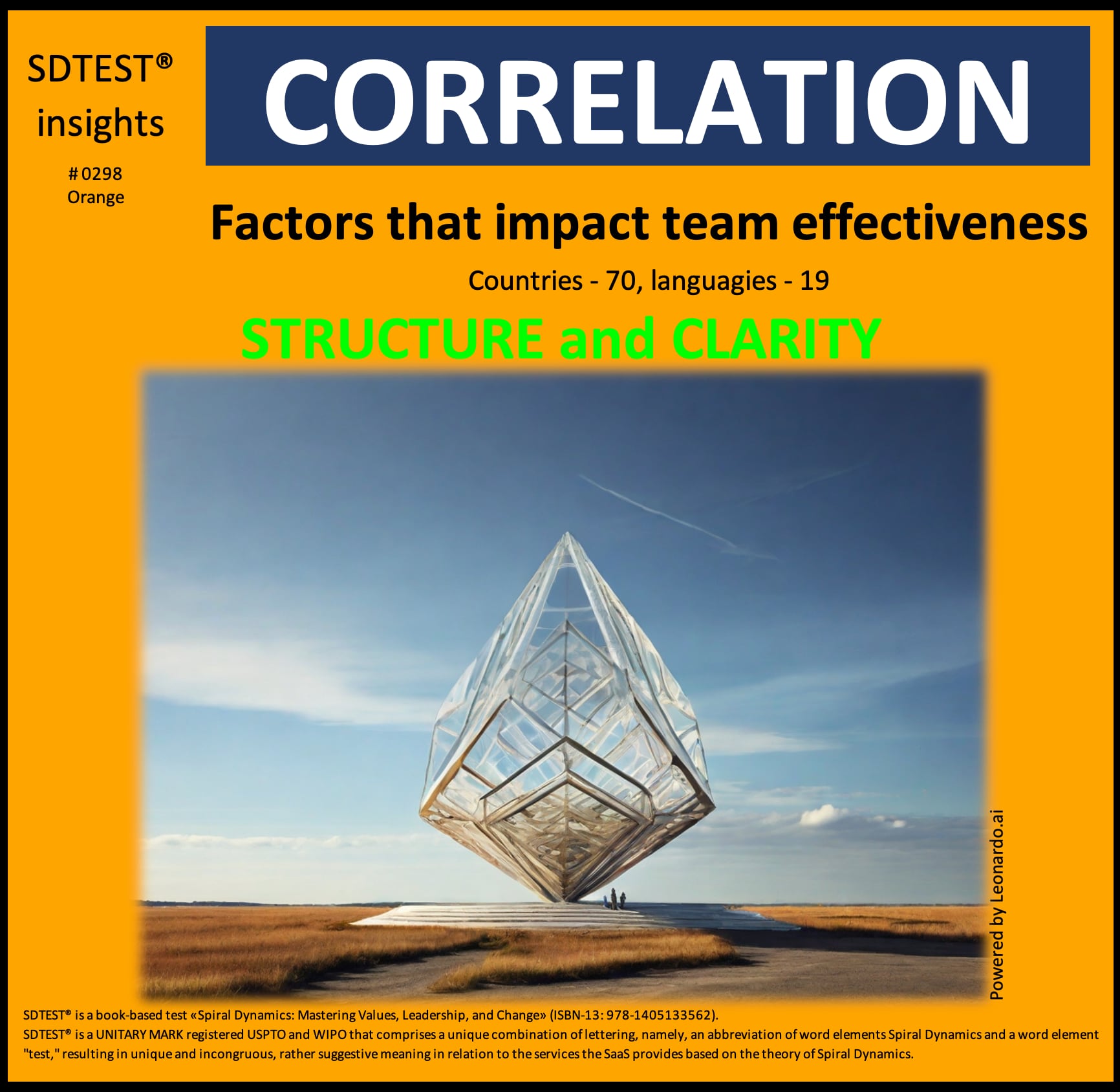
This positive correlation of 0.0957 between "Structure and clarity" as a factor impacting team effectiveness and the Orange stage offers intriguing insights when viewed through the lens of the Orange value system:
Organizational Perspective:
Organizations operating within the Orange mindset might interpret this correlation as:
- Validation of their belief in the importance of logical, rational processes and well-defined structures.
- Confirmation that ambiguity and lack of clarity can undermine the efficient achievement of organizational goals.
- Evidence supporting their view that optimizing systems and procedures is critical to driving progress and innovation.
These organizations might respond by:
- Implementing even more rigorous planning, goal-setting, and performance measurement frameworks.
- Standardizing and documenting team processes to maximize clarity and consistency.
- Promoting leaders who excel at defining and communicating clear, actionable objectives.
Team Perspective:
Teams operating from an Orange mindset might approach this correlation by:
- Viewing it as an affirmation of their preference for well-structured, analytically-driven ways of working.
- Interpreting it supports their practice of establishing explicit roles, responsibilities, and decision-making protocols.
- Seeing it as validation for prioritizing efficiency, productivity, and achieving measurable outcomes over more subjective or flexible team dynamics.
These teams might respond by:
- Regularly reviewing and optimizing their internal processes to eliminate ambiguity and redundancy.
- Encouraging team members to take a data-driven, problem-solving approach to improving team effectiveness.
- Celebrating instances where the team can execute on well-defined goals and objectives rapidly.
Individual Perspective:
Individuals aligned with the Orange value system might interpret this correlation as:
- Personal validation of their belief that structure and clarity are essential for high performance.
- Evidence supporting their intuition that ambiguity and lack of direction are detrimental to individual and team success.
- Confirmation of the value they place on rationality, objectivity, and the application of scientific principles.
These individuals might respond by:
- Actively advocating for implementing more robust planning, measurement, and accountability frameworks within their teams.
- Viewing a lack of structure and clarity as a personal failing or an obstacle to be overcome through analytical problem-solving.
- Using data and logic to challenge team practices or leadership approaches they perceive as insufficiently structured or defined.
This positive correlation, viewed through the Orange lens, suggests that those operating at the Orange level may be more likely to value "Structure and clarity" as a critical factor in team effectiveness. It implies that the Orange value system's emphasis on reason, science, and goal-oriented thinking aligns with a preference for well-defined, systematically optimized team environments.
However, the reasons why "Structure and clarity" might not be seen as the most critical factors impacting team effectiveness in the Orange stage could include:
- Overemphasis on Efficiency: The Orange stage's focus on optimizing systems and processes could lead to an overreliance on structure at the expense of other important factors, such as adaptability or employee engagement.
- Belief in Individual Capability: In the Orange stage, there may be a strong belief that high-performing individuals can succeed regardless of the team environment, diminishing the perceived importance of structure and clarity.
- Prioritization of Innovation: The Orange stage's drive for progress and technological advancement could lead to a preference for more flexible, exploratory team dynamics that challenge the status quo.
- Overconfidence in Rational Analysis: Orange-stage thinking may overestimate the ability of logical, data-driven approaches to capture the complexities of team dynamics and effectiveness fully.
- Neglect of Interpersonal Factors: The Orange stage's emphasis on results and efficiency could lead to a relative disregard for the importance of communication, trust, and psychological safety within teams.
This correlation prompts us to consider how different value systems influence perceptions of the key drivers of team effectiveness. It raises questions about the potential benefits and limitations of a strictly Orange approach to team management, particularly in contexts where adaptability, creativity, and employee well-being are crucial.
Ultimately, this correlation highlights the complex interplay between cultural values, organizational priorities, and team performance. In Orange-dominant environments, the perceived importance of structure and clarity may be high. Still, there may also be a need to balance these factors with other aspects of team dynamics and effectiveness.
In our analysis of the poll "Three Distinct Possibilities of the Future" (by Dr. Clare W. Graves), we found an intriguing positive correlation that warrants closer examination:
0.3996 between the Massive regression back to our stone-age beginnings if we fail to stabilize our world's weapons and endangered resources and the Green stage.
The critical value of the correlation coefficient for a normal distribution, by William Sealy Gosset (Student) r = 0.32. This positive correlation of 0.3996 meets the reliability criteria but does not necessarily imply causation.
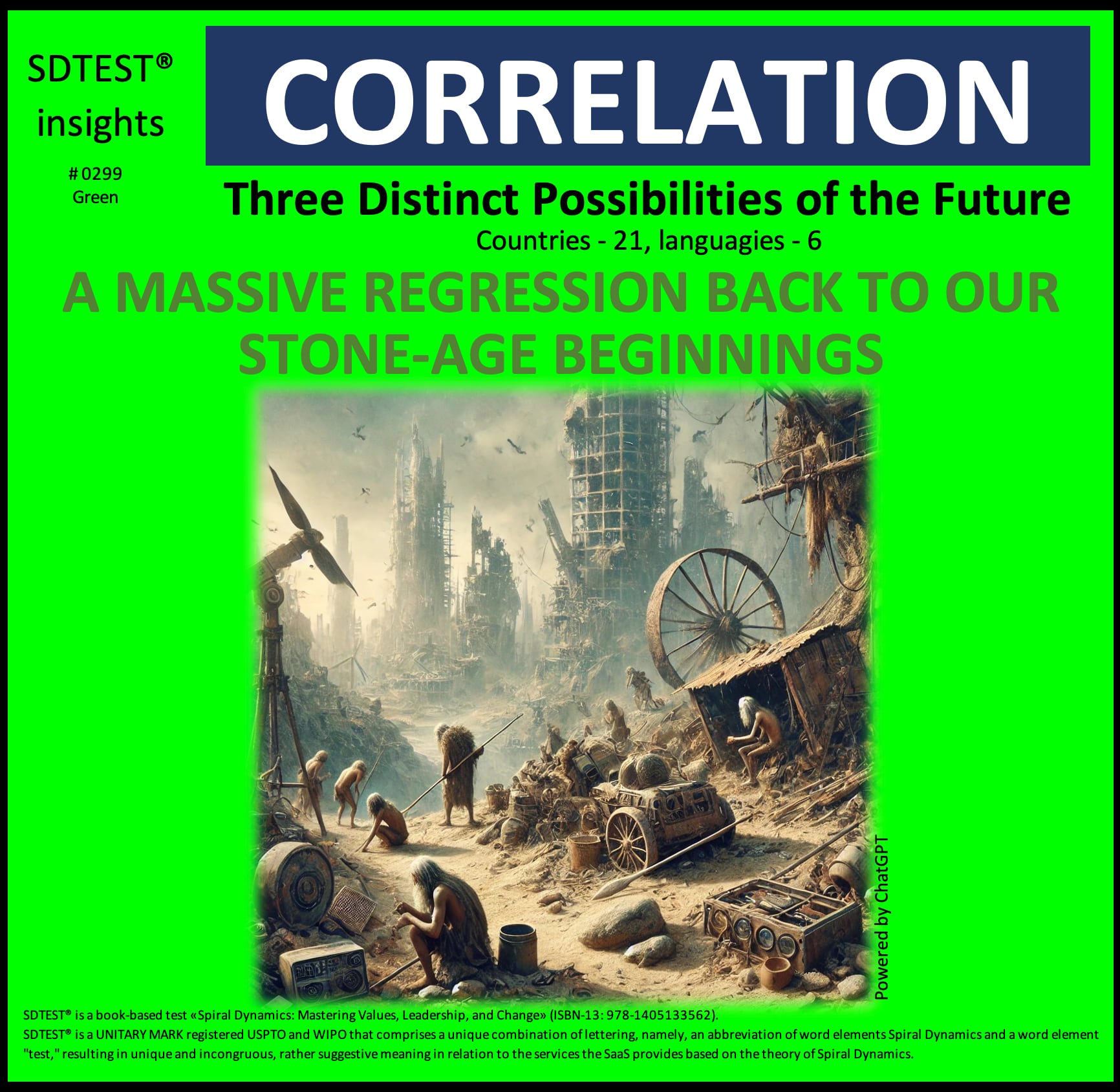
This positive correlation of 0.3996 between "Massive regression back to our stone-age beginnings if we fail to stabilize our world's weapons and endangered resources" and the Green stage offers profound insights when viewed through the lens of the Green value system:
Organizational Perspective:
Organizations operating within the Green mindset might interpret this correlation as:
- Validation of their commitment to sustainability, ecological preservation, and the well-being of all living systems.
- Confirmation that they have a vital role in averting a catastrophic regression that would threaten the very foundations of human civilization.
- Evidence supporting their belief that proactive, holistic solutions are necessary to address the existential risks facing humanity and the planet.
These organizations might respond by:
- Prioritizing, developing, and implementing comprehensive strategies to safeguard endangered resources and reduce the threat of global conflicts.
- Advocating for collaborative, cross-sector initiatives that bring together diverse stakeholders to tackle complex, interconnected challenges.
- Restructuring their operations and supply chains to minimize their ecological footprint and promote sustainable, regenerative practices.
Team Perspective:
Teams operating from a Green mindset might approach this correlation by:
- Viewing it as an affirmation of their responsibility to contribute to the greater good of humanity and the natural world.
- Interpreting it as support for their commitment to systems-level thinking and their willingness to challenge traditional assumptions.
- Seeing it as validation for prioritizing collective well-being, cooperation, and long-term sustainability over narrow, short-term interests.
These teams might respond by:
- Actively seeking out opportunities to apply their specialized knowledge and skills to address global weapons, resources, and environmental degradation issues.
- Fostering a culture of open dialogue, empathy, and collective problem-solving to tackle the world's complex, interconnected challenges.
- Celebrating instances where their efforts have a tangible, positive impact on people's lives and the planet's health.
Individual Perspective:
Individuals aligned with the Green value system might interpret this correlation as:
- Personal validation of their deep concern for the future of humanity and their sense of responsibility to be a force for positive change.
- Evidence supporting their intuition that the continuation of our species and the integrity of the biosphere are inextricably linked.
- Confirmation of the value they place on holistic, systemic approaches to addressing global issues and their belief in the power of collective action.
These individuals might respond by:
- Actively engaging in advocacy, volunteering, or other forms of civic participation to raise awareness and drive action on the critical issues highlighted by the correlation.
- Viewing their personal and professional choices as opportunities to contribute to a more sustainable, equitable, and peaceful world.
- Seeking opportunities to collaborate with like-minded individuals and organizations to develop and implement innovative solutions to global challenges.
This positive correlation, viewed through the Green lens, suggests that those operating at the Green level are acutely aware of the existential risks posed by the failure to stabilize global weapons and endangered resources. It implies that the Green value system's emphasis on systems-level thinking, ecological preservation, and collective well-being aligns with a deep sense of urgency and responsibility to address these critical issues.
The reasons why "Massive regression back to our stone-age beginnings if we fail to stabilize our world's weapons and endangered resources" might be seen as a distinct possibility of the future by those in the Green stage could include:
- Interconnectedness: Green-stage thinking recognizes the profound interconnectedness of all living systems and the understanding that the destabilization of one component can have catastrophic, cascading effects on the whole.
- Ecological Fragility: The Green stage acknowledges the delicate balance of the planet's ecosystems and the fragility of the natural resources that sustain human civilization, making the prospect of a total systemic collapse profoundly concerning.
- Collective Responsibility: In the Green stage, there is a strong sense of shared responsibility for the well-being of humanity and the biosphere, leading to a sense of urgency in addressing global threats.
- Holistic Solutions: The Green stage's emphasis on systems-level thinking and collaborative, interdisciplinary solutions makes the prospect of a regressive, fragmented future especially worrying and motivates a search for more comprehensive, integrated responses.
- Sustainability and Equity: The Green stage's values of sustainability and concern for the equitable distribution of resources make the idea of a return to a "stone-age" existence deeply antithetical to their worldview and aspirations for the future.
This correlation makes us consider how advanced value systems, such as the Green stage, can provide a profoundly nuanced and holistic understanding of humanity's interconnected challenges. It raises questions about the potential for Green-stage thinking to inspire and catalyze the collaborative, systems-level solutions necessary to avert the most catastrophic outcomes and ensure a more sustainable, equitable, and prosperous future for all.
Ultimately, this correlation highlights the Green stage's profound sense of responsibility and the urgency with which it approaches the critical issues of our time. In the face of such existential risks, those operating within the Green value system are likely to be driven by a deep commitment to safeguarding the future of our species and the health of the planet we all call home.
In our analysis of the poll "My Greatest Fears," we found an intriguing positive correlation that warrants closer examination:
0.0757 between the Arbitrary rule of the authorities and the Yellow stage.
The critical value of the correlation coefficient for a normal distribution, by William Sealy Gosset (Student) r = 0.0334. This positive correlation of 0.0757 meets the reliability criteria but does not necessarily imply causation.

This positive correlation of 0.0757 between "Arbitrary rule of the authorities" as the greatest fear and the Yellow stage offers intriguing insights when viewed through the lens of the Yellow value system:
Organizational Perspective:
Companies operating within the Yellow mindset might interpret this correlation as:
- Validation of their commitment to flexible, adaptive structures that empower individuals and foster innovation.
- Confirmation that rigid, top-down authority can stifle the complex problem-solving abilities needed in today's rapidly changing world.
- Evidence supporting their belief in the importance of transparent, merit-based decision-making processes.
These organizations might respond by:
- Implementing more fluid, network-based organizational structures, allowing rapid adaptation and self-organization.
- Fostering a culture of open dialogue and constructive challenge to authority, encouraging all members to contribute their unique perspectives.
- Develop leadership approaches emphasizing facilitation and enabling rather than command and control.
Team Perspective:
Teams operating from a Yellow mindset might approach this correlation by:
- Viewing it as an affirmation of their preference for self-directed, purpose-driven collaboration over rigid hierarchies.
- Interpreting it supports their practice of questioning assumptions and continuously refining their approaches based on emerging data and insights.
- Seeing it as validation for prioritizing collective intelligence and diverse perspectives in decision-making processes.
These teams might respond by:
- Actively cultivating an environment where team members feel empowered to challenge ideas regardless of their source.
- Implementing dynamic role allocation based on competence and context rather than fixed positions of authority.
- Celebrating instances where the team successfully navigates complex challenges through emergent, collaborative solutions rather than top-down directives.
Individual Perspective:
Individuals aligned with the Yellow value system might interpret this correlation as:
- Personal validation of their drive for autonomy, continuous learning, and the ability to contribute their unique talents without arbitrary constraints.
- Evidence supports their intuition that rigid authority structures are ill-equipped to address our time's complex, interconnected challenges.
- Confirmation of the value they place on integrative thinking and the ability to navigate multiple perspectives and value systems.
These individuals might respond by:
- Actively seeking out or creating work environments that allow for high degrees of personal agency and creative problem-solving.
- Viewing encounters with arbitrary authority as opportunities to engage in constructive dialogue and promote more adaptive, inclusive approaches.
- Developing their capacity to understand and work effectively across different value systems, fostering change from within.
This positive correlation, viewed through the Yellow lens, suggests that those operating at the Yellow level are particularly sensitive to and concerned about arbitrary authority's limitations and potential negative impacts. It implies that the Yellow value system's emphasis on integration, complexity, and adaptive problem-solving aligns with a strong aversion to rigid, top-down control mechanisms.
The reasons why "Arbitrary rule of the authorities" might be seen as the greatest fear in the Yellow value system could include the following:
- Complexity Awareness: Yellow-stage thinking recognizes systems' inherent complexity and interdependence, making simplistic, arbitrary rule-making appear dangerously reductive and potentially harmful.
- Adaptability Imperative: The Yellow stage values the ability to rapidly adapt to changing circumstances, which arbitrary, inflexible authority structures can severely hamper.
- Integrative Perspective: Yellow thinkers strive to integrate insights from multiple value systems and perspectives, making them acutely aware of the limitations of singular, arbitrary viewpoints.
- Personal Agency: The Yellow stage values individual autonomy and the ability to contribute one's unique talents, which can be stifled under arbitrary rules.
- Systemic Impact: Those in the Yellow stage understand how arbitrary authority can have far-reaching, often unintended consequences throughout complex systems, potentially leading to suboptimal or even disastrous outcomes.
This correlation prompts us to consider how advanced value systems, such as the Yellow stage, can provide nuanced insights into the nature of effective governance and decision-making in complex environments. It raises questions about how organizations and societies can evolve beyond rigid hierarchies to more adaptive, inclusive structures that can effectively navigate the challenges of our rapidly changing world.
In our analysis of the poll "The main priorities of job seekers," we found an intriguing negative correlation that warrants closer examination:
-0.0749 between the Financial compensation and the Turquoise stage.
The critical value of the correlation coefficient for a normal distribution, by William Sealy Gosset (Student) r = 0.0613. This negative correlation of -0.0749 meets the reliability criteria but does not necessarily imply causation.

This negative correlation of -0.0749 between "Financial compensation" as a priority for job seekers and the Turquoise stage offers intriguing insights when viewed through the lens of the Turquoise value system:
Organizational Perspective:
Companies operating within the Turquoise mindset might interpret this correlation as:
- Validation of their holistic approach to employee well-being that goes beyond financial rewards.
- Confirmation that purpose-driven work aligned with ecological and social values is a powerful motivator.
- Evidence supports their belief in creating work environments that nurture the interconnectedness of all aspects of life.
These organizations might respond by:
- Reimagining compensation packages to include non-monetary benefits that support personal growth, community engagement, and environmental stewardship.
- Implementing policies that allow employees to dedicate time to social and environmental causes as part of their work.
- Developing organizational structures that emphasize collaboration, shared purpose, and the integration of work with broader life goals.
Team Perspective:
Teams operating from a Turquoise mindset might approach this correlation by:
- Viewing it as an affirmation of their focus on creating meaningful, impactful work that contributes to the greater good.
- Interpreting it as support for their practice of valuing diverse contributions beyond traditional metrics of productivity or profit.
- Seeing it as validation for prioritizing team cohesion, shared values, and collective growth over individual financial gain.
These teams might respond by:
- Actively cultivating a team culture that celebrates contributions to sustainability, social justice, and holistic well-being.
- Implementing collaborative decision-making processes that consider the broader impact of team actions on all stakeholders, including the environment.
- Exploring innovative ways to measure and reward team success beyond financial metrics, incorporating social and ecological impact.
Individual Perspective:
Individuals aligned with the Turquoise value system might interpret this correlation as:
- Personal validation of their desire to find work that aligns with their holistic worldview and contributes to global well-being.
- Evidence supporting their intuition that personal fulfillment and societal impact are more important than financial gain.
- Confirmation of the value they place on jobs that allow for personal growth, spiritual development, and connection with the broader universe.
These individuals might respond by:
- Actively seeking job opportunities that prioritize sustainability, social responsibility, and holistic approaches to business.
- Viewing their career choices as opportunities to contribute to the evolution of consciousness and the healing of social and ecological systems.
- Advocating for workplace practices that honor the interconnectedness of all aspects of life, including work-life integration rather than mere balance.
This negative correlation, viewed through the Turquoise lens, suggests that those operating at the Turquoise level are less likely to prioritize financial compensation in their job search. It implies that the Turquoise value system's emphasis on holistic well-being, interconnectedness, and global consciousness aligns with a shift away from purely monetary motivations in career choices.
The reasons why "Financial compensation" might not be seen as essential for job seekers in the Turquoise stage could include:
- Holistic Perspective: Turquoise-stage thinking recognizes that true well-being encompasses far more than financial wealth, leading to a broader definition of personal and professional success.
- Global Consciousness: Those in the Turquoise stage are deeply aware of global challenges and may prioritize work that addresses these issues over personal financial gain.
- Spiritual Fulfillment: The Turquoise value system often includes a spiritual dimension that values inner growth and cosmic connection over material accumulation.
- Interconnected View of Prosperity: Turquoise thinkers may view prosperity as a collective state that includes ecological health and social harmony rather than individual financial wealth.
- Long-term Sustainability Focus: The emphasis on long-term sustainability in the Turquoise stage may make short-term financial gains less significant than enduring positive impact.
This correlation prompts us to consider how advanced value systems, such as the Turquoise stage, can reshape our understanding of work, success, and fulfillment. It raises questions about how organizations can evolve to attract and retain individuals with these highly developed value systems, potentially leading to more sustainable and socially responsible business models.
Ultimately, this correlation highlights the Turquoise stage's profound shift in priorities from individual material gain to collective well-being and global harmony. In Turquoise-dominant contexts, the relative lack of emphasis on financial compensation likely stems from a deep understanding of the interconnectedness of all things and a desire to contribute to the evolution of consciousness and the healing of our world.
What insights do you gain from today's correlation? How might we study this relationship more carefully before deducing causation?
We welcome respectful and wise perspectives! Stay tuned every week as we share more results and insights.
After login or registration, free access to the poll results in the FAQ section.
[1] https://www.linkedin.com/in/wmba/
2024.10.27
FearpersonqualitiesprojectorganizationalstructureRACIresponsibilitymatrixCritical ChainProject Managementfocus factorJiraempathyleadersbossGermanyChinaPolicyUkraineRussiawarvolatilityuncertaintycomplexityambiguityVUCArelocatejobproblemcountryreasongive upobjectivekeyresultmathematicalpsychologyMBTIHR metricsstandardDEIcorrelationriskscoringmodelGame TheoryPrisoner's Dilemma
Valerii Kosenko
Mea nona ka huahana SaaS SDTEST®
Ua kūpono ʻo Valerii ma ke ʻano he kanaka aʻoaʻo-psychologist ma 1993 a ua hoʻohana ʻo ia i kona ʻike i ka hoʻokele papahana.
Ua loaʻa iā Valerii ke kēkelē laeoʻo a me ka hōʻailona papahana a me ka manakia papahana ma 2013. I ka wā o kāna papahana Master, ua kamaʻāina ʻo ia me Project Roadmap (GPM Deutsche Gesellschaft für Projektmanagement e. V.) a me Spiral Dynamics.
ʻO Valerii ka mea kākau o ka ʻimi ʻana i ka maopopo ʻole o ka V.U.C.A. manaʻo e hoʻohana ana i ka Spiral Dynamics a me ka helu makemakika i loko o ka psychology, a me 38 mau koho balota.










